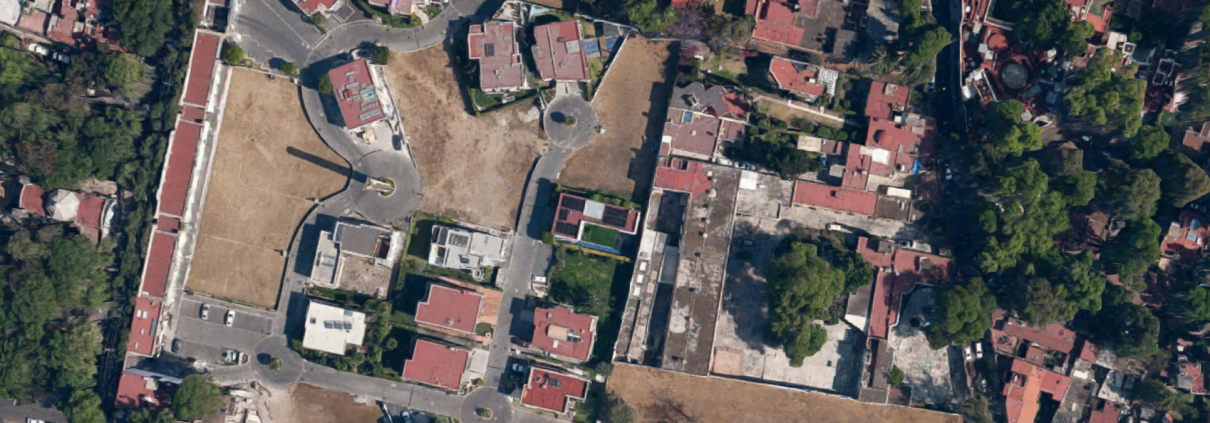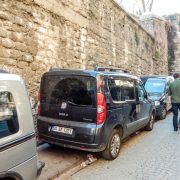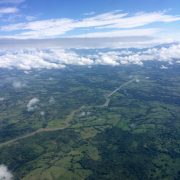Open and closed: Walking around Fortress Coyoacán
By Thomas Abbot, MURP ’18
The experience of walking in Mexico City can run the gamut from serene and calming to white-knuckle stressful. The parks seem made for the casual stroll, with no shortage of things to admire and an easy flow of people. By contrast, some streets present forbidding walls and hair-thin sidewalks, forcing confrontation with automobile traffic in every step. My adopted neighborhood of Coyoacán is relatively dense and compact, easy to experience on foot, but the design of the neighborhood has quirks that sometimes make the pedestrian experience unpleasant. I spend most days at work at WRI Mexico staring at documents about rental subsidies and spatial segregation, aware but dismissive of the music and street food smells outside. For a change of pace, I thought I’d get outside a bit and offer my (amateurish) thoughts on urban design in the neighborhood. The contrast between the openness of commercial buildings and the closed-off nature of nearly all residential architecture is striking and worthy of some thought.
Coyoacan was originally independent from Mexico City. Home to the Tepanec people, it was Spanish conquistador Hernan Cortes’s base as he attacked Tenochtitlan, the Aztec capital upon which Mexico City was built. Despite having been swallowed by urban expansion, it retains some of the architecture and bizarre street grids of the colonial era. It is a wealthy neighborhood, home to ample green space, fancy restaurants, and Crossfit gyms.
Public space and openness to the public are the norm in the center of Coyoacan. Restaurants are generally outward facing, sometimes with two walls completely open in a style only seen in cities with mild climates. Street life is almost overwhelming in the neighborhood’s historic center, especially on the weekends when each sidewalk is lined with stalls and shouting parking attendants. When walking through the sizeable Mercado de Coyoacán (the local market), you’re never really sure if you’re inside or outside. Additionally, the neighborhood is full of small squares, each of which is old and inviting. Elderly couples sit on wrought iron benches and people walk their dogs in the morning. I was once offered fidget spinners and grasshoppers in quick succession by intrepid salespeople in one of these squares (I purchased neither).
If this all sounds pretty nice, I can assure you it is. Then why do the people who live here hide from it so thoroughly? This is a trend I’ve noticed elsewhere in Latin America, but it’s particularly notable here given the relative safety and tranquility of the area. Frequently, a home’s façade will be a solid wall broken only by the door for the garage. A look at satellite imagery shows just how many homes are in the center of blocks, completely hidden from the street.
The degree to which rich residents of the neighborhood shield their homes from street life reminds me to a certain degree of the classic Not-In-My-Backyard (NIMBY) residents of Los Angeles. What is illustrated is a certain ambivalence or lack of commitment to the idea of living in a city. No one can have an extensive yard or enforce minimum lot sizes in Coyoacán, so the solution is high walls and inner courtyards. In some cases, the streets themselves are abruptly gated off, generally with a kiosk and a sleepy guard. The result is a strange patchwork of public, private and semi-private space. The streets are beautiful and tree-lined, but pedestrians can only get a hint of what lies on the other side of the walls. Sometimes I find myself walking very quickly down the street for no reason, as the subconscious implication of this architecture is that I am not welcome and should move along.
The easy answer to explain this phenomenon is high prevalence of crime. However, a quick look at statistics shows that Coyoacan is not particularly notable for non-violent crimes, and has very low levels of violent crime by the city’s standards. This doesn’t stop residents from putting up anti-crime signs, or the police from camping out in the square, but it does illustrate that the fear behind these actions is to some degree unfounded. High levels of crime in the past could also play a role, although even newer building exhibit the same characteristics.
I have often been left wondering what the neighborhood would be like if some of those walls came down, and if the division between these two types of space was a little less stark. Would people stop and linger on the street more? Would the neighborhood feel less divided? Would crime increase? Or, following Jane Jacobs’s classic argument around “eyes on the street,” would crime levels come down with more interaction between houses and public space? Such a change is very unlikely, so this hypothesis will never be tested. But what a lovely neighborhood it would create.













